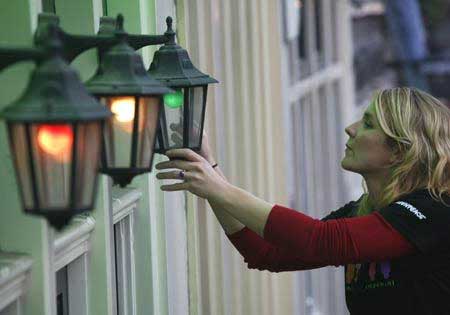
What are incandescent bulbs?
Incandescent bulbs are the common household light bulb. They were invented in 1879, last for an average of a year and waste 95 per cent of their energy as heat. But despite these massive energy and waste problems, incandescents still account for around 80 per cent of bulbs in UK homes. (Find out more)
What are Compact Fluorescent Lamps (CFLs) and fluorescent tubes?
Compact fluorescent lamps (also known as energy saving bulbs) were introduced in the early 1980s and they use only 20 per cent of the energy needed by incandescents to produce the same light output. They last up to 12 times as long and can save consumers around £9 a year. Despite this, they account for only around 13 per cent of UK sales. (Find out more)
What are halogen bulbs?
The halogen lamp are around 50-100 percent more efficient than incandescents and last twice as long, but they’re still nowhere near as good as CFLs. They account for around seven percent of sales in the UK. The EU has set a target of date 2016 to phase out halogen bulbs. Any bulb available for
purchase after that must have at least a 'B' energy rating. (Find out more)
How do the different bulbs work?
All three bulbs produce artificial light by sending an electrical current through one medium or another. For incandescents, the current passes through a filament, heating it up and causing it to release photons. For CFLs, the electrical current passes through a gas filled tube, which then emits ultraviolet light. The ultraviolet light excites a white phosphor coating on the inside of the tube, which emits visible light. Halogen bulbs send an electrical current through a tungsten filament, inside a halogen gas envelope.
How much energy could the UK save by switching incandescents to CFLs?
Of the nearly 600 million bulbs in UK homes (25-odd bulbs per household), around four-fifths are incandescent. These incandescents create around 6.4 million tonnes of carbon dioxide every year. If we changed all these incandescents to CFLs, we could save just over five million tonnes worth of carbon dioxide - more than the CO2 emissions of the 26 lowest emitting countries combined! In energy terms, we’d save 11.8 terawatts a year – or two medium coal or nuclear power stations’ worth...
How much money could consumers save on their electric bills?
Going by the average UK electricity unit cost in 2006 (10.2 pence), consumers could save on average £50 per household – or 15 percent of the average household electricity bill. That’s a total of over £1.2 billion every year.
Which compact fluorescent bulb should I buy?
The Energy Savings Trust has a wide variety of accredited compact fluorescent bulbs – look at the full list.


